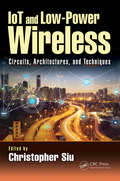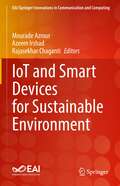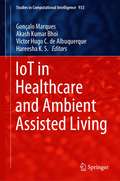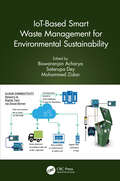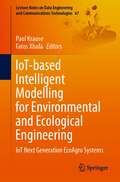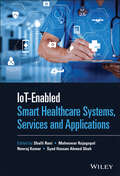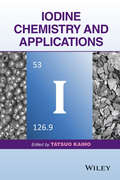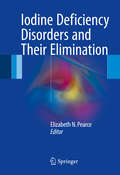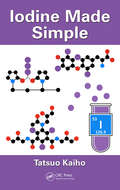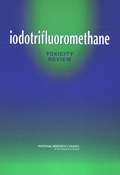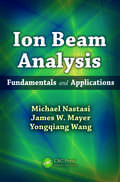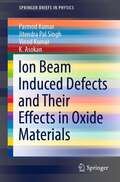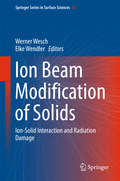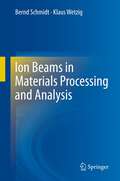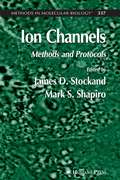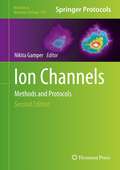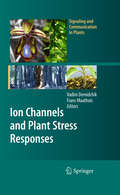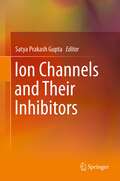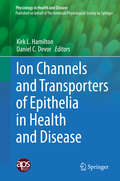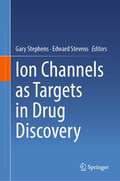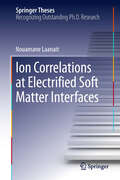- Table View
- List View
IoT and Low-Power Wireless: Circuits, Architectures, and Techniques (Devices, Circuits, and Systems)
by Christopher SiuThe book offers unique insight into the modern world of wireless communication that included 5G generation, implementation in Internet of Things (IoT), and emerging biomedical applications. To meet different design requirements, gaining perspective on systems is important. Written by international experts in industry and academia, the intended audience is practicing engineers with some electronics background. It presents the latest research and practices in wireless communication, as industry prepares for the next evolution towards a trillion interconnected devices. The text further explains how modern RF wireless systems may handle such a large number of wireless devices. <li>Covers modern wireless technologies (5G, IoT), and emerging biomedical applications <li>Discusses novel RF systems, CMOS low power circuit implementation, antennae arrays, circuits for medical imaging, and many other emerging technologies in wireless co-space. <li>Written by a mixture of top industrial experts and key academic professors.
IoT and Smart Devices for Sustainable Environment (EAI/Springer Innovations in Communication and Computing)
by Mourade Azrour Azeem Irshad Rajasekhar ChagantiThis book presents research related to smart devices and Internet of Things (IoT) that are intended to advance environmental sustainability. With sustainability as the focus, the topics covered include designing and controlling of smart systems, networking and machine learning, monitoring and controlling the environment, smart metering, authentication and authorization, and software and systems solution. The authors discuss how IoT can aid in sustainability through its implementation of systems interconnecting several objects, whether in the physical or in the virtual worlds. The chapters also present several applications including in smart homes, transportation, and healthcare. The book pertains to researchers, academics, and professionals.
IoT for Smart Grids: Design Challenges and Paradigms (Power Systems)
by Dimitrios Soudris Kostas Siozios Dimitrios Anagnostos Elias KosmatopoulosThis book explains the fundamentals of control theory for Internet of Things (IoT) systems and smart grids and its applications. It discusses the challenges imposed by large-scale systems, and describes the current and future trends and challenges in decision-making for IoT in detail, showing the ongoing industrial and academic research in the field of smart grid domain applications.It presents step-by-step design guidelines for the modeling, design, customisation and calibration of IoT systems applied to smart grids, in which the challenges increase with each system’s increasing complexity. It also provides solutions and detailed examples to demonstrate how to use the techniques to overcome these challenges, as well as other problems related to decision-making for successful implementation. Further, it anaylses the features of decision-making, such as low-complexity and fault-tolerance, and uses open-source and publicly available software tools to show readers how they can design, implement and customise their own system control instantiations.This book is a valuable resource for power engineers and researchers, as it addresses the analysis and design of flexible decision-making mechanisms for smart grids. It is also of interest to students on courses related to control of large-scale systems, since it covers the use of state-of-the-art technology with examples and solutions in every chapter. And last but not least, it offers practical advice for professionals working with smart grids.
IoT in Healthcare and Ambient Assisted Living (Studies in Computational Intelligence #933)
by Akash Kumar Bhoi Victor Hugo C. de Albuquerque Gonçalo Marques Hareesha K. S.This book presents the state of the art of Internet of Things (IoT) from the perspective of healthcare and Ambient Assisted Living (AAL). It discusses the emerging technologies in healthcare services used for healthcare professionals and patients for enhanced living environments and public health. The topics covered in this book include emerging eHealth IoT applications, Internet of Medical Things, health sensors, and wearable sensors for pervasive and personalized healthcare, and smart homes applications for enhanced health and well-being. The book also presents various ideas for the design and development of IoT solutions for healthcare and AAL. It will be useful for bioengineers and professionals working in the areas of healthcare as well as health informatics.
IoT, AI, and ICT for Educational Applications: Technologies to Enable Education for All (EAI/Springer Innovations in Communication and Computing)
by Stamatios PapadakisThis book provides insight into the importance of advanced innovative technologies such as the Internet of Things (IoT), artificial intelligence (AI), and Metaverse as part of information and communication technology (ICT) solutions in education. Key features of this book include the recent and emerging developments in various specializations in education and finding their solutions by incorporating IoT, AI and ICT. This book presents useful applications, interventions, and case studies that cater to their improved requirements. Topics include formal and services based on IoT; AI technology for IoT-based educational delivery; interfacing devices to IoT; smart educational services; ChatGPT; Smartbots; and more. The authors include several practical solutions and applications of IoT and ICT in education. The book applies to researchers, academics, students, educators and practitioners around the world.
IoT, Machine Learning and Blockchain Technologies for Renewable Energy and Modern Hybrid Power Systems
by P. Sanjeevikumar P. Sivaraman C. Sharmeela Meera JosephThis edited book comprises chapters that describe the IoT, machine learning, and blockchain technologies for renewable energy and modern hybrid power systems with simulation examples and case studies. After reading this book, users will understand recent technologies such as IoT, machine learning techniques, and blockchain technologies and the application of these technologies to renewable energy resources and modern hybrid power systems through simulation examples and case studies.
IoT-Based Smart Waste Management for Environmental Sustainability (Smart and Intelligent Computing in Engineering)
by Biswaranjan Acharya, Satarupa Dey, and Mohammed ZidanThis book consolidates and summarizes smart technologies like IoT, edge computing, and AI used in different aspects of waste material management, mitigation, and recycling for a sustainable environment. One of the cases explains how IoT-based systems and wireless sensors can be used to continuously detect common pollutants such as volatile organic compounds (VOCs), carbon monoxide, and particulate matter (PM) and how the data collected are used to assess the overall air quality and determine actions for improvements. A collection of practical case studies, this book provides a comprehensive knowledge in smart waste management to readers in universities, research centers, and industries.
IoT-based Intelligent Modelling for Environmental and Ecological Engineering: IoT Next Generation EcoAgro Systems (Lecture Notes on Data Engineering and Communications Technologies #67)
by Fatos Xhafa Paul KrauseThis book brings to readers thirteen chapters with contributions to the benefits of using IoT and Cloud Computing to agro-ecosystems from a multi-disciplinary perspective. IoT and Cloud systems have prompted the development of a Cloud digital ecosystem referred to as Cloud-to-thing continuum computing. The key success of IoT computing and the Cloud digital ecosystem is that IoT can be integrated seamlessly with the physical environment and therefore has the potential to leverage innovative services in agro-ecosystems. Areas such as ecological monitoring, agriculture, and biodiversity constitute a large area of potential application of IoT and Cloud technologies. In contrast to traditional agriculture systems that have employed aggressive policies to increase productivity, new agro-ecosystems aim to increase productivity but also achieve efficiency and competitiveness in modern sustainable agriculture and contribute, more broadly, to the green economy and sustainable food-chain industry. Fundamental research as well as concrete applications from various real-life scenarios, such as smart farming, precision agriculture, green agriculture, sustainable livestock and sow farming, climate threat, and societal and environmental impacts, is presented. Research issues and challenges are also discussed towards envisioning efficient and scalable solutions to agro-ecosystems based on IoT and Cloud technologies. Our fundamental belief is that we can collectively trigger a new revolution that will transition agriculture into an equable system that not only feeds the world, but also contributes to mitigating the climate change and biodiversity crises that our historical actions have triggered.
IoT-enabled Smart Healthcare Systems, Services and Applications
by Neeraj Kumar Shalli Rani Maheswar Rajagopal Syed Hassan Ahmed Shah>IoT-Enabled Smart Healthcare Systems, Services and Applications Explore the latest healthcare applications of cutting-edge technologies In IoT-Enabled Smart Healthcare Systems, Services and Applications, an accomplished team of researchers delivers an insightful and comprehensive exploration of the roles played by cutting-edge technologies in modern healthcare delivery. The distinguished editors have included resources from a diverse array of learned experts in the field that combine to create a broad examination of a rapidly developing field. With a particular focus on Internet of Things (IoT) technologies, readers will discover how new technologies are impacting healthcare applications from remote monitoring systems to entire healthcare delivery methodologies. After an introduction to the role of emerging technologies in smart health care, this volume includes treatments of ICN-Fog computing, edge computing, security and privacy, IoT architecture, vehicular ad-hoc networks (VANETs), and patient surveillance systems, all in the context of healthcare delivery. Readers will also find: A thorough introduction to ICN-Fog computing for IoT based healthcare, including its architecture and challenges Comprehensive explorations of Internet of Things enabled software defined networking for edge computing in healthcare Practical discussions of a review of e-healthcare systems in India and Thailand, as well as the security and privacy issues that arise through the use of smart healthcare systems using Internet of Things devices In-depth examinations of the architecture and applications of an Internet of Things based healthcare system Perfect for healthcare practitioners and allied health professionals, hospital administrators, and technology professionals, IoT-Enabled Smart Healthcare Systems, Services and Applications is an indispensable addition to the libraries of healthcare regulators and policymakers seeking a one-stop resource that explains cutting-edge technologies in modern healthcare.
Iodine Chemistry and Applications
by Tatsuo KaihoThis book comprehensively covers iodine, its chemistry, and its role in functional materials, reagents, and compounds.* Provides an up-to-date, detailed overview of iodine chemistry with discussion on elemental aspects: characteristics, properties, iodides, and halogen bonding* Acts as a useful guide for readers to learn how to synthesize complex compounds using iodine reagents or intermediates* Describes traditional and modern processing techniques, such as starch, cupper, blowing out, and ion exchange resin methods* Includes seven detailed sections devoted to the applications of iodine: Characteristics, Production, Synthesis, Biological Applications, Industrial Applications, Bioorganic Chemistry and Environmental Chemistry, and Radioisotopes * Features hot topics in the field, such as hypervalent iodine-mediated cross coupling reactions, agrochemicals, dye sensitized solar cells, and therapeutic agents
Iodine Deficiency Disorders and Their Elimination
by Elizabeth N. PearceThis volume summarizes the current understanding of the effects of severe and mild-to-moderate iodine deficiency as well as iodine excess. It also discusses best practices for salt iodization, the mainstay of global IDD prevention efforts, and other forms of food fortification. The effectiveness of iodine supplementation for vulnerable populations, an evolving strategy in many regions, is also described. Iodine is an essential micronutrient and an integral component of the thyroid hormones, which are required for normal growth and development. The iodine deficiency disorders (IDD) encompass a spectrum of adverse health effects including goiter, cretinism, hypothyroidism, growth retardation, and increased pregnancy loss and infant mortality. Thyroid hormone is particularly crucial for neurodevelopment in early life. Insufficient maternal iodine intake during pregnancy may result in neurological and cognitive deficits in children. Salt iodization and other preventive strategies have substantially improved iodine nutrition worldwide. Consequently, severely iodine-deficient regions are uncommon at present and public health concern has shifted toward mild-to-moderate iodine deficiency. Despite gains, however, IDD is still considered the leading preventable cause of intellectual impairment worldwide. Excessive iodine intake can cause alterations in thyroid function in susceptible individuals; defining safe upper levels for chronic iodine intake has been challenging. Low-level environmental exposure to chemicals such as perchlorate and thiocyanate which competitively block thyroidal iodine uptake appears to be ubiquitous worldwide. There has been recent concern that such environmental exposures might pose a health hazard by inducing or aggravating underlying thyroid dysfunction. This up-to-date volume explores both the effects of iodine deficiency as well as the best strategies for prevention.
Iodine Made Simple
by Tatsuo KaihoIodine Made Simple is a unique volume that explains the basic properties of iodine as well as the products and technology using it. Included are eight sections: What Is Iodine?, Iodine around Us, Iodine That Sustains Electronic and Information Materials, Using Iodine for Analysis, Innovative Industrial Technology Starts with Iodine, Iodine Is Needed to Maintain Health, Iodine for Vegetable Production and Livestock Breeding, and Next-Generation Technology Starts with Iodine. As the importance of iodine in many facets of everyday life continues to grow, this book provides valuable information for the scientifically literate public and undergraduate university students interested in this field.
Iodotrifluoromethane: Toxicity Review
by Subcommittee on IodotrifluoromethaneThe U.S. military is considering using a compound called iodotrifluoromethane (CF3I) for fire suppression to replace previously-used compounds (halons) that are being phased out because they deplete the ozone layer. This report reviews available toxicological data on CF3I and evaluates the scientific basis of the U.S. Army's proposed exposure limit of 2,000 parts per million (ppm). The report recommends that CF3I be used for fire suppression in normally unoccupied spaces because of its potential to cause cardiac sensitization in test animals. The report also recommends that further genotoxicity testing be conducted (testing for changes in genetic material), and that CF3I be assessed for its potential to cause cancer. Should the Army decide to use CF3I, information should be collected and evaluated on how much of the chemical or any of its degradation products might be released and how often.
Ion Beam Analysis: Fundamentals and Applications
by Michael Nastasi James W. Mayer Yongqiang WangIon Beam Analysis: Fundamentals and Applications explains the basic characteristics of ion beams as applied to the analysis of materials, as well as ion beam analysis (IBA) of art/archaeological objects. It focuses on the fundamentals and applications of ion beam methods of materials characterization.The book explains how ions interact with solids
Ion Beam Induced Defects and Their Effects in Oxide Materials (SpringerBriefs in Physics)
by Vinod Kumar Parmod Kumar Jitendra Pal Singh K. AsokanThis book provides an overview of the applications of ion beam techniques in oxide materials. Oxide materials exhibit defect-induced physical properties relevant to applications in sensing, optoelectronics and spintronics. Defects in these oxide materials also lead to magnetism in non-magnetic materials or to a change of magnetic ordering in magnetic materials. Thus, an understanding of defects is of immense importance. To date, ion beam tools are considered the most effective techniques for producing controlled defects in these oxides. This book will detail the ion beam tools utilized for creating defects in oxides.
Ion Beam Modification of Solids
by Werner Wesch Elke WendlerThis book presents the method of ion beam modification of solids in realization, theory and applications in a comprehensive way. It provides a review of the physical basics of ion-solid interaction and on ion-beam induced structural modifications of solids. Ion beams are widely used to modify the physical properties of materials. A complete theory of ion stopping in matter and the calculation of the energy loss due to nuclear and electronic interactions are presented including the effect of ion channeling. To explain structural modifications due to high electronic excitations, different concepts are presented with special emphasis on the thermal spike model. Furthermore, general concepts of damage evolution as a function of ion mass, ion fluence, ion flux and temperature are described in detail and their limits and applicability are discussed. The effect of nuclear and electronic energy loss on structural modifications of solids such as damage formation, phase transitions and amorphization is reviewed for insulators and semiconductors. Finally some selected applications of ion beams are given.
Ion Beams in Materials Processing and Analysis
by Klaus Wetzig Bernd SchmidtA comprehensive review of ion beam application in modern materials research is provided, including the basics of ion beam physics and technology. The physics of ion-solid interactions for ion implantation, ion beam synthesis, sputtering and nano-patterning is treated in detail. Its applications in materials research, development and analysis, developments of special techniques and interaction mechanisms of ion beams with solid state matter result in the optimization of new material properties, which are discussed thoroughly. Solid-state properties optimization for functional materials such as doped semiconductors and metal layers for nano-electronics, metal alloys, and nano-patterned surfaces is demonstrated. The ion beam is an important tool for both materials processing and analysis. Researchers engaged in solid-state physics and materials research, engineers and technologists in the field of modern functional materials will welcome this text.
Ion Channels
by James D. Stockand Mark S. ShapiroThe diverse applications in this volume range from the study of allosteric regulation of ion channel activity using a classic mutagenesis approach, to the study of channel subunit stoichiometry using a novel biophysical approach based on fluorescence resonance energy transfer. Highlights include methods for heterologous expression of ion channels in cells, for determining channel structure-function, and for studying channel regulation.
Ion Channels
by Nikita GamperEvery cell in our bodies contains a great variety and number of permeability pathways for various organic and inorganic ions, water, metabolites, nutrients, and signalling molecules. Maintenance and precise control of gating within these pathways are fundamental principles of life as these underlie basic cellular functions such as communication, contractility, and metabolism. In Ion Channels: Methods and Protocols, Second Edition, experts in the field contribute chapters that focus on the strategies, approaches, methods, and protocols for studying a large family of proteins that form ionic channels in the plasma membrane and intracellular membranes of cells. Using practical examples from the cutting-edge current research, this volume will take a look back at the major methods and approaches that aided the progress toward the current understanding of ion channel function, structural design, and biological roles. The volume also aims to look forward and identify approaches that will lead us to future discoveries. Written in the highly successful Methods in Molecular BiologyTM series format, chapters include introductions to their respective topics, lists of the necessary materials and reagents, step-by-step, readily reproducible laboratory protocols, and tips on troubleshooting and avoiding known pitfalls. Authoritative and cutting-edge, Ion Channels: Methods and Protocols, Second Edition will greatly assist researchers searching for specific methodology in studying ion channels on the path toward a greater understanding of these key biological features.
Ion Channels and Plant Stress Responses
by Frans J.M. Maathuis Vadim DemidchikThis book aims to provide a range of perspectives on an area that is very topical at present in plant biology: the role of ion channels in plant stress responses. Functions of cation and anion channels in the sensing and encoding of major biotic and abiotic stimuli, stress signal transduction and metabolism adjustment are examined at the cellular and molecular levels. Particular emphases of the book are on new insights into plant Ca2+ signaling, salinity tolerance mechanisms, cyclic nucleotide gated channels and the regulation of stress reactions among oxygen-derived species.
Ion Channels and Their Inhibitors
by Satya Prakash GuptaBeing the crucial components of living cells, ion channels are important targets of therapeutic agents. Historically, it has been challenging to develop drugs on this target class. A major issue with target based ion channel drug development is the identification of effective small chemical leads for medicinal chemistry optimization to the clinical candidate status. Thus enough attention has been paid to the study of structure and functions of ion channels and their potential inhibitors. The present book compiles important chapters authored by eminent workers in the field to cover important recent advances in the studies of the structure and functions of ion channels and their inhibitors, such as sodium ion, potassium ion, chloride ion, calcium ion channel inhibitors. The book may be of great use to the students and scientists working in the area of molecular biology, biochemistry, physiology, neurobiology, and medicinal chemistry.
Ion Channels and Transporters of Epithelia in Health and Disease
by Kirk L. Hamilton Daniel C. DevorThis book sheds new light on the physiology, molecular biology and pathophysiology of epithelial ion channels and transporters. It combines the basic cellular models and functions by means of a compelling clinical perspective, addressing aspects from the laboratory bench to the bedside. The individual chapters, written by leading scientists and clinicians, explore specific ion channels and transporters located in the epithelial tissues of the kidney, intestine, pancreas and respiratory tract, all of which play a crucial part in maintaining homeostasis. Further topics include the fundamentals of epithelial transport; mathematical modeling of ion transport; cell volume regulation; membrane protein folding and trafficking; transepithelial transport functions; and lastly, a discussion of transport proteins as potential pharmacological targets with a focus on the pharmacology of potassium channels.
Ion Channels as Targets in Drug Discovery
by Gary Stephens Edward StevensThis book is built around ion channel research and, more specifically, ion channels as important therapeutic drug targets. Under the editorial leadership of Gary Stephens in academic research and Edward Stevens from industry, the aim is to bring these strands together to provide a cutting-edge translational reference on ion channel drug discovery. Exploiting our knowledge of ion channel structure and function has clear current and future potential to intervene and correct the pathophysiology associated with debilitating conditions, including cardiovascular disease, diabetes, cystic fibrosis, pain, epilepsy, and neurodegenerative disorders. Individual chapters have a disease focus, also providing a “case study story” that will also appeal to a clinical audience, while background information on a given ion channel is presented to provide a solid reference for undergraduate and postgraduate teaching.
Ion Channels in Biophysics and Physiology (Advances in Experimental Medicine and Biology #1349)
by Lei ZhouThis book gathers relatively recent and significant topics in the field of ion channel research. Ion channels form the molecular basis for membrane excitability in cells from the cardiovascular and nervous systems. In many non-excitable cells, ion channels contribute to diverse function including secretion of signaling compounds like hormones and insulin, cell volume regulation, intracellular signaling especially Ca2+ signaling, etc. Many human diseases have been attributed to abnormal channel functions and defective membrane expression of channel proteins. On the other hand, ion channels are excellent models for studying protein biophysics, especially the allosteric regulation of protein function by miscellaneous stimuli. Therefore, researches on ion channels carry significant meaning for the understanding of basic protein biophysics and diverse physiological functions and for developing novel and effective treatment for related human diseases. This book could provide graduates and scientists in both basic and clinical levels, a comprehensive understanding of cutting-edge advances and a useful and stimulating platform for tackling their own questions about ion channels.
Ion Correlations at Electrified Soft Matter Interfaces
by Nouamane LaanaitIon Correlations at Electrified Soft Matter Interfaces presents an investigation that combines experiments, theory, and computer simulations to demonstrate that the interdependency between ion correlations and other ion interactions in solution can explain the distribution of ions near an electrified liquid/liquid interface. The properties of this interface are exploited to vary the coupling strength of ion-ion correlations from weak to strong while monitoring their influence on ion distributions at the nanometer scale with X-ray reflectivity and on the macroscopic scale with interfacial tension measurements. This thesis demonstrates that a parameter-free density functional theory that includes ion-ion correlations and ion-solvent interactions is in agreement with the data over the entire range of experimentally tunable correlation coupling strengths. The reported findings represent a significant advance towards understanding the nature and role of ion correlations in charged soft-matter. Ion distributions underlie many scientific phenomena and technological applications, including electrostatic interactions between charged biomolecules and the efficiency of energy storage devices. These distributions are determined by interactions dictated by the chemical properties of the ions and their environment, as well as the long-range nature of the electrostatic force. The presence of strong correlations between ions is responsible for counterintuitive effects such as like-charge attraction.
